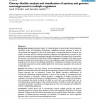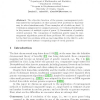24 search results - page 3 / 5 » Genome Rearrangements with Partially Ordered Chromosomes |
JCB
2008
13 years 4 months ago
2008
Accurately reconstructing the large-scale gene order in an ancestral genome is a critical step to better understand genome evolution. In this paper, we propose a heuristic algorit...
BMCBI
2007
13 years 4 months ago
2007
Background: Identifying syntenic regions, i.e., blocks of genes or other markers with evolutionary conserved order, and quantifying evolutionary relatedness between genomes in ter...
RECOMB
2005
Springer
14 years 5 months ago
2005
Springer
Abstract. The objective function of the genome rearrangement problems allows the integration of other genome-level problems so that they may be solved simultaneously. Three example...
RECOMB
2002
Springer
14 years 5 months ago
2002
Springer
Comparing chromosomal gene order in two or more related species is an important approach to studying the forces that guide genome organization and evolution. Linked clusters of si...
CORR
2010
Springer
13 years 3 months ago
2010
Springer
Given two genomes with duplicate genes, Zero Exemplar Distance is the problem of deciding whether the two genomes can be reduced to the same genome without duplicate genes by delet...


